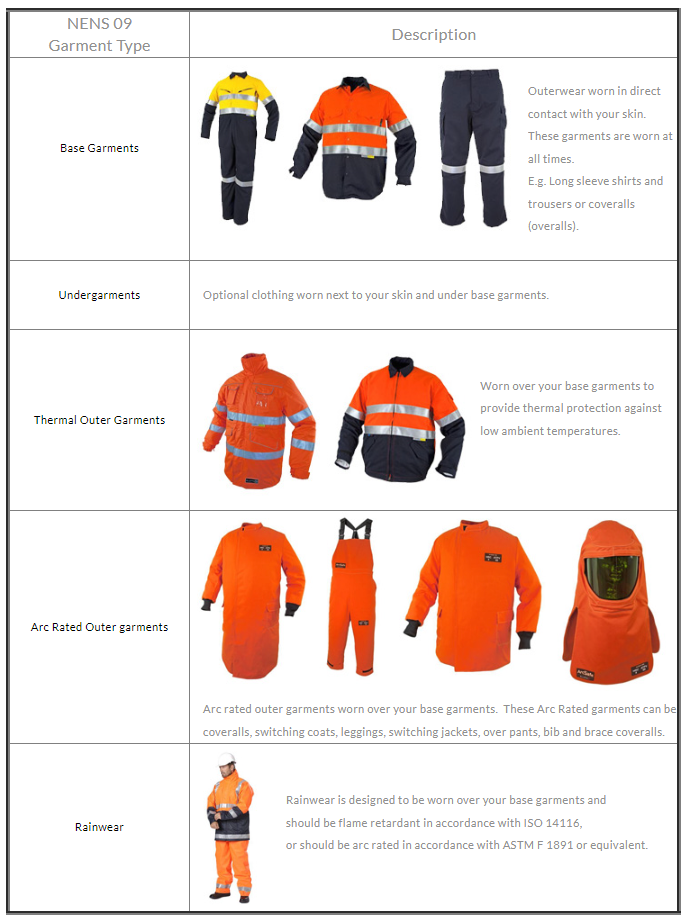NENS09 2014? What’s that all about?

NENS09 2014 - What It Is and What It Means To You
Did you know that Energy Networks Australia (ENA) has revised NENS 09? This month, changes to the National Guideline for the selection, use, and maintenance of Personal Protective Equipment for Electrical Arc Hazards have come into effect and amongst many other things – they influence what’s deemed “safe” for you to wear to work! The review has brought the standard into line with the current developments in testing and flame-retardant clothing – which is great news!
So, what does this mean for you?
We asked manufacturing expert, Elliotts Managing Director Anthony Elliott to explain how these changes influence the quality safety gear that you wear to work…
Clothing or Garment Types
To date, protective clothing has been grouped into two main categories:
1. Primary Protective Clothing - switching hoods, coats/ leggings, jackets, and pants
2. Secondary Protective Clothing - everyday work wear, shirts, trousers, and coveralls
However, the new NENS 09 2014 provides a greater level of detail in relation to clothing types.
For that reason, I’ve put together a table for you which simplifies the NENS 09 clothing categories:

Base Garments
⦿ Base garments manufactured from arc-rated materials worn where there is the possibility of exposure to incident energy of 5J/cm2 (1.2cal/cm2) or
⦿ Above the recommended minimum ATPV for base garments is 16.7J/cm2 (4cal/cm2)
Undergarments
⦿ They should not exacerbate injury in the event of an arc flash
⦿ Manufactured from a minimum of 90% natural fiber
• Wool is a great suitable, as it presents no ignition risk
• Untreated cotton, although unsuitable for base garments, is acceptable for undergarments.
So just, make sure that you are wearing the appropriate Base Garment.
REMEMBER: Flammable, melting synthetic undergarments should never be worn – ever!
Thermal Outer Garments
Thermal outer garments are garments worn over base garments to provide thermal protection against low ambient temperatures e.g. jackets and pullovers.
⦿ Not essential that these garments be arc rated
⦿ The outer layer should be flame retardant in accordance with ISO 14116
⦿ Must have no flammable melting synthetic layers or components
⦿ I would also recommend heavy woolen knitwear or felted spun wool blanketing fabric
IMPORTANT: Remember that any garment which is not arc-rated should not be relied upon to provide additional or increased arc protection.
Arc Rated Outer Garments
Arc Rated garments are worn when higher levels of arc protection is required and must be worn over base garments.
These include the following:
⦿ Coveralls
⦿ Switching coat and leggings
⦿ Switching jacket and over pants or bib and brace coveralls
Water and electricity never mix, rainwear is designed to be worn over base garments.
Rainwear should either be
⦿ Flame retardant in accordance with ISO 14116
⦿ Or arc rated in accordance with ASTM F 1891 or equivalent
REMEMBER: Rainwear garments that are not arc-rated should never be relied upon to provide additional or increased arc protection
Also, rainwear should not be treated with additional products other than those specified by the manufacturer.
At the end of the day, changes to standards can be confusing and we at Elliotts are here to help! So, if you want to find out more on how we can assist you to meet the new NENS 09 clothing standard or recommend appropriate garments to your customers – we are only too happy to help! Simply contact us, it’s that simple.
Take care,
ANTHONY ELLIOTT
CONTACT US
If you'd like to learn about our safety products or need some expert advice on which safety gear to get for your needs, feel free to contact us at Elliotts Australia. We would love to assist you! Call us on 07 3265 2944 or send us a message.







